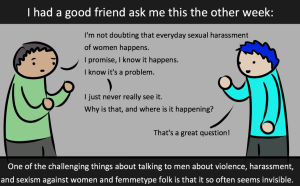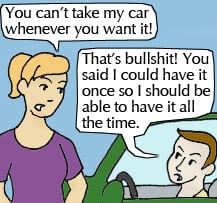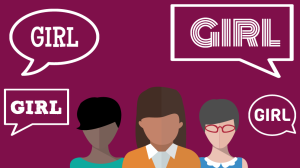Hey y’all. I’m back. I haven’t made a video for a while because I’ve been busy, going on a trip and then moving to Montreal and I was starting my PhD, and it’s all been really busy and overwhelming. Now that I’m starting to settle in a bit, I want to start making videos more, so in that vein, this is another video in a series with Everyday Feminism which is a website dedicated to helping you break down and stand up to everyday oppression.
In this video, I want to discuss the ways that people use the same term feminism to refer to two actually different movements and scopes.
One way that the term feminism is used is to describe a woman focused movement, focusing on sexism and sexist oppression against women. It’s a historical movement and the way that the term is most easily understood, I would say. However, there’s also another way feminism is used and that’s to refer to a broader movement. Feminism might also refer to what we do here at Everyday Feminism, the fight to end all kinds of oppression. This may or may not be directly regarding women.
Women will certainly gain freedom if oppressive systems are dismantled, as women are still oppressed in many ways due to their identity as women, however feminism as a broader movement is interested in freeing all genders and agender people from all oppressions. It’s a movement which focuses on more than just gender based oppression against women.
Let’s talk a little bit about these two kinds of feminism. First, there’s the woman centered feminism. That’s the way that most people think of feminism at a surface level. Men’s rights activists hear feminism and think that means for women only. Feminism hates men. It’s in the name. Feminism evokes this women focused movement which fights for the liberation of women from patriarchal oppression. The movement has been going on for many decades and has focused on legal inequalities, women’s suffrage, educational reform, cultural inequalities, gender norms, femininity, et cetera.
It’s a fight that’s far from being over, but we have made historical strides within that movement. There are valid reasons, I think, for wanting our feminism to be women focused. It began with a study in activism of woman against oppressors. Women focused feminism, I think, does have the ability to recognize that patriarchal systems constrain more than just women, but remain focused on creating spaces for women to be safe, and working against societal pressures and constraints still placed on women.
However, this kind of feminism is also hurtful, and potentially harmful. It hurts gender minorities and trans women, by focusing mainly on the oppression, or only on the oppression and experiences of cis women. This is exclusionary and it doesn’t actually help to advance women as a whole, because it leaves out some women who don’t fit a certain mold. It also excludes people who don’t identify as women or men, but who still experience gender based oppression too.
Some feminists identify with the notion of feminism as being for women’s liberation, the women’s lib movement. While that’s technically true of feminism, it doesn’t actually capture all the ways that different kinds of oppression will effect women. It does nothing to account for the ways those oppressions affect people who are not women.
That leads me to the second, I think more modern version of what feminism is, and that is feminism as a broader, anti-oppression movement. Often, people just call this intersectional feminism. That’s a term coined by an American professor named Kimberle Crenshaw in the late 80s, so this concept has been a part of women of color’s, and especially black women’s feminism all along, but it has made its way into the mainstream more recently no doubt, due to the tireless efforts of feminists of color.
This broader feminism is intersectional in the sense that it describes multiple, critical theories of ways that different but related oppressions and oppressive institutions are interconnected and they can’t properly be examined separately from each other.
These institutions include racism, sexism, homo antagonism, trans antagonism, ableism, classism and more. These are all related. To look at only sexism, the plight of women, rather than looking at other oppressions which intersect with sexism for many women, so racism will intersect with sexism for a woman of color.
Ableism will intersect with trans antagonism for a trans person with disabilities. There are millions of people who live at the cross hairs of different oppressive institutions and systems, and it’s modern feminism’s goal to address all of these institutions so that we can all be free.
Think of it like this. If you have an infection and you want to cure that infection, you could try certain techniques for cleaning it or trying to eat differently, something like that. Let’s say you eventually realize that there’s a larger condition that’s causing that infection, and in fact that condition is infecting other parts of your body too. It’s obviously in your best interest to treat the condition so that all of your infections can heal rather than just focusing on one infection.
Treating your condition might be more complicated than you might think. It might be more than just taking a pill and they all go away. It may involve examining what is underlying all of these infections, how they’re related or different from each other and trying a combination of techniques to try to cure them all.
That’s kind of a weird example, but it’s meant to show that by focusing only on ending sexist oppression against women, we ignore many other oppressive systems which will ultimately end up oppressing many of those same women as well as many other people.
To best treat, that is, get rid of sexism, we have to look at racism, ableism, et cetera. We need to examine oppression more widely and cure the entire concept from our society.
It can be confusing when some people use the term feminism to refer to women focused feminism and others are using it to refer to intersectional anti oppression feminism, and this tension can make it hard to know exactly who is being addressed. For instance, non-binary people are oppressed because of their gender, so they ought to find a place in feminism.
The name of feminism doesn’t necessarily suggest that their gender oppression is part of the problem being addressed, but it is part of the problem. We need to make that clear and I don’t think that we need to change the name of feminism to do that. Feminism is ultimately a collection of movements that recognize oppression of all sorts affecting a wide range of people.
It’s okay that feminism evokes a long history of fighting against women’s oppression. It’s also okay then that plenty of folks choose not to use feminism for good reasons like womanists often do to their historical exclusion from that mainstream feminist movement I talked about at the beginning.
The meaning of terms can change over time, while still holding on to their history. That’s what’s so important about maintaining feminism as our term, while remembering that we have the power to use it for more than just our own quality. I hope that that explains and helps pull apart those two usages of the same term, and I will see you in my next video. Thanks y’all.




















